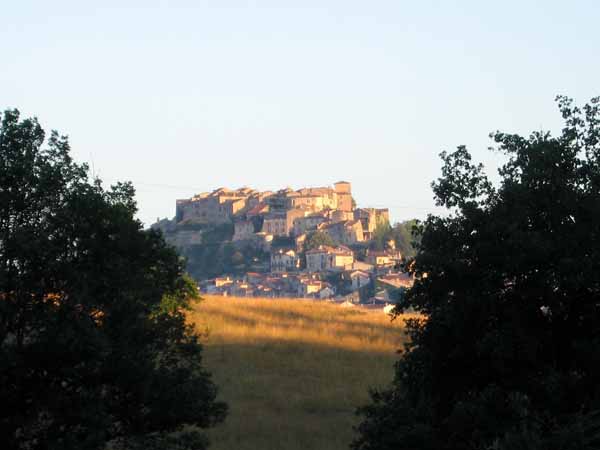
Thursday, 21 July 2005
Distance 31 km
Duration 6 hours 30 minutes
Ascent 363 m, descent 343 m
Map 57 of the TOP100 blue series (now superseded)
Map 64 of the TOP100 blue series (now superseded)
Perhaps as a result of the Châteauneuf-du-Pape, we slept in slightly, only waking at 6:20, but with some effort we managed to leave just on 7.
We had to walk on the highway at first, which was no trouble at that hour, and we got along so well that we overshot our turn-off and had to take the next one.
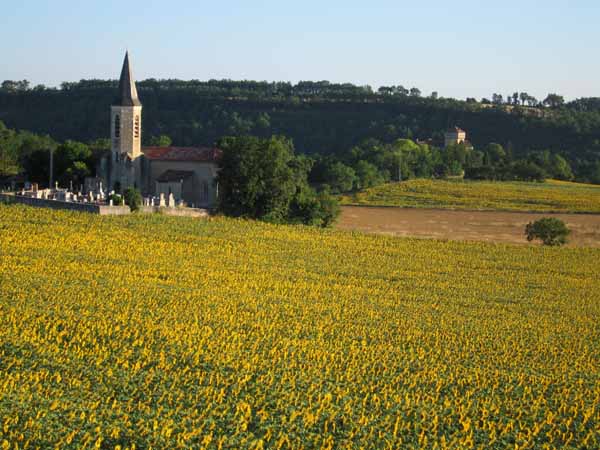
Fields of sunflowers had their faces all turned to the front like good schoolgirls.
We got to Virac, had a rest and a snack by the road and continued at a fast pace, always on roads but small ones.
Skirting the solitary church of Saint-Jean-le-Froid and crossing a bridge over an artificial lake, we strode on into a forest.
We were ready for another pause but could not find an agreeable place to sit down.
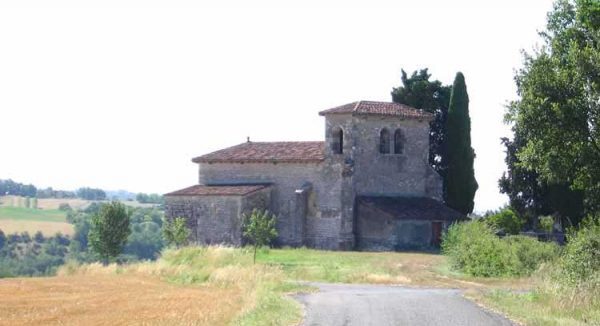
Then the road became tortuous as we started to descend, and before us on the plain the town of Albi appeared, with its one huge pink building, the cathedral. Before long we were down in the outer streets.
It was 11:45 and we thought we could still make it to the centre in time to see the Tour de France riders depart.
We almost ran through the ugly streets, which were completely empty and seemed to go on for ever.

At last we saw a mass of people ahead of us and at that moment they turned and began to disperse towards us.
We had walked 28 km in 5 hours and missed the start by just a few minutes!
We tasted disappointment with our coffee, but it was still delicious after five hours of heavy walking.
All around were the attributes of the Tour – the barricades, the gendarmes, the trailing crowds with their balloons and T-shirts, the banners across the street – everything except the riders.

After we had recovered we set off over the bridge amongst the still streaming throng, and found our way to the cathedral, a mighty fortress of brick set in a wide square.
It was built in the 13th and 14th centuries after the repression of the Albigensian heresy, as a declaration of the power of the established church, and it certainly has a threatening exterior.
At the edge of the square, next to the Toulouse-Lautrec museum, we discovered the Office of Tourism and found out that the camping ground was a couple of kilometres away to the east.
But our immediate interest was in lunch, so we bought some bread, cheese and mackerel and sat down in the doorway of a government building to eat.
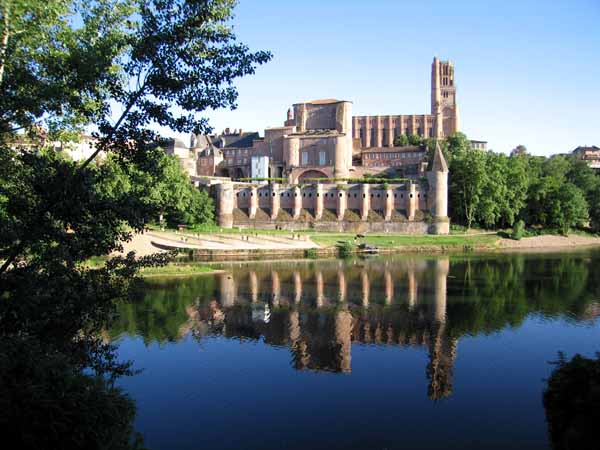
An old woman hobbled over to us (I thought she was a beggar) to tell us there was a little park just down the lane opposite. This was a much better place, with wooden benches surrounded by flower beds.
A stone-faced fellow was smoking meditatively on the other bench, observing us in silence. When we had all but finished, he cleared his throat and informed us that, although he was late in saying so, he wished us bon appétit. The formal courtesy of the French is a constant delight.
We spent a long time at the internet parlour a few streets away sending an email, and when we emerged it was even hotter than before.
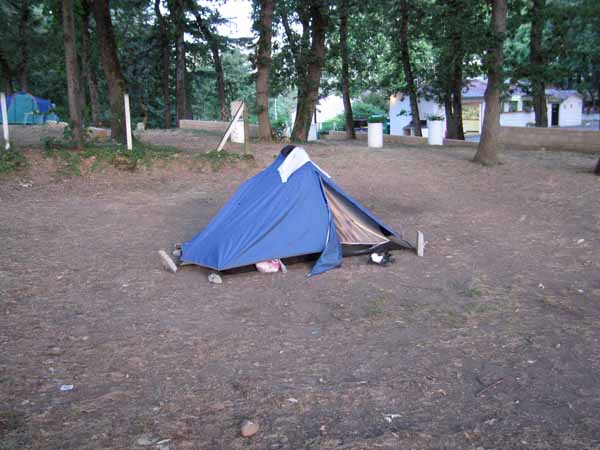
On the way to the camping ground we dodged from one meagre patch of shade to the next. It was a typical strip of run-down premises along the highway, but eventually, just past a huge cemetery, we arrived.
The woman in charge was horrified that we had walked so far on such a day, and offered us the use of the big area normally reserved for groups, as it had a table and benches. What it did not have was grass, and we were reduced to using chunks of concrete to support the pegs of the tent. None of the other plots had grass either.
A GB campervan came up beside us and turned out to contain a couple of New Zealanders, who promptly invited us to have a cup of tea with them. This was a great novelty for us.
They had only two cups and two chairs but we managed with the aid of beer mugs and the step of the van. We had a madeleine each as well so it was excellent. They were about to go back to NZ after six years in London, and intended to start a cheese company in Blenheim.

We had quick showers, hung our washing on the wire-netting fence and marched back to town. It seemed just as hot, but the shadows were longer.
As a concession to tourism, we walked down to the Old Bridge, the original source of the town’s wealth, built in the eleventh-century and never washed away.
On the other bank was the quarter known as Madeleine, a good place from which to see the cathedral reflecting itself in the Tarn.

Returning at more of a crawl than a canter, up the steep lane to the cathedral, we sank into chairs at a bar in the shadow of the belltower. A glass of rosé cooled us down enough to consider where to dine.
The best place was the big Place du Vigan, which was a mass of eateries.
We ended up in a brasserie called Brussel’s (a chain) and had the plat du jour, which was steak with frites and salad, not elaborate but very good all the same, with a half-litre of red.
Previous day: Laguépie to Cordes-sur-Ciel